Analysis of Child Immunization in the US: A Public Health Report
VerifiedAdded on 2020/05/16
|23
|5424
|104
Report
AI Summary
This report delves into the public health system of the United States, specifically focusing on child immunization. It highlights the importance of immunization in ensuring long-term health and community well-being. The report examines the decline in vaccination rates due to vaccine hesitancy, explores the psychological factors influencing parental decisions, and analyzes the role of healthcare providers in addressing parental concerns. The report includes a detailed research recruitment plan, emphasizing the use of audio-visual broadcasts and interviews to educate and understand the target population. An annotated bibliography provides summaries and critiques of relevant journal articles, focusing on the challenges faced by healthcare providers, the causes of under-immunization, and parental attitudes towards vaccination. The research study design tool and the rationale for the research methodology are discussed, along with data collection and analysis methods. The report concludes by emphasizing the importance of addressing public health concerns related to child immunization and the need for effective strategies to promote vaccination.
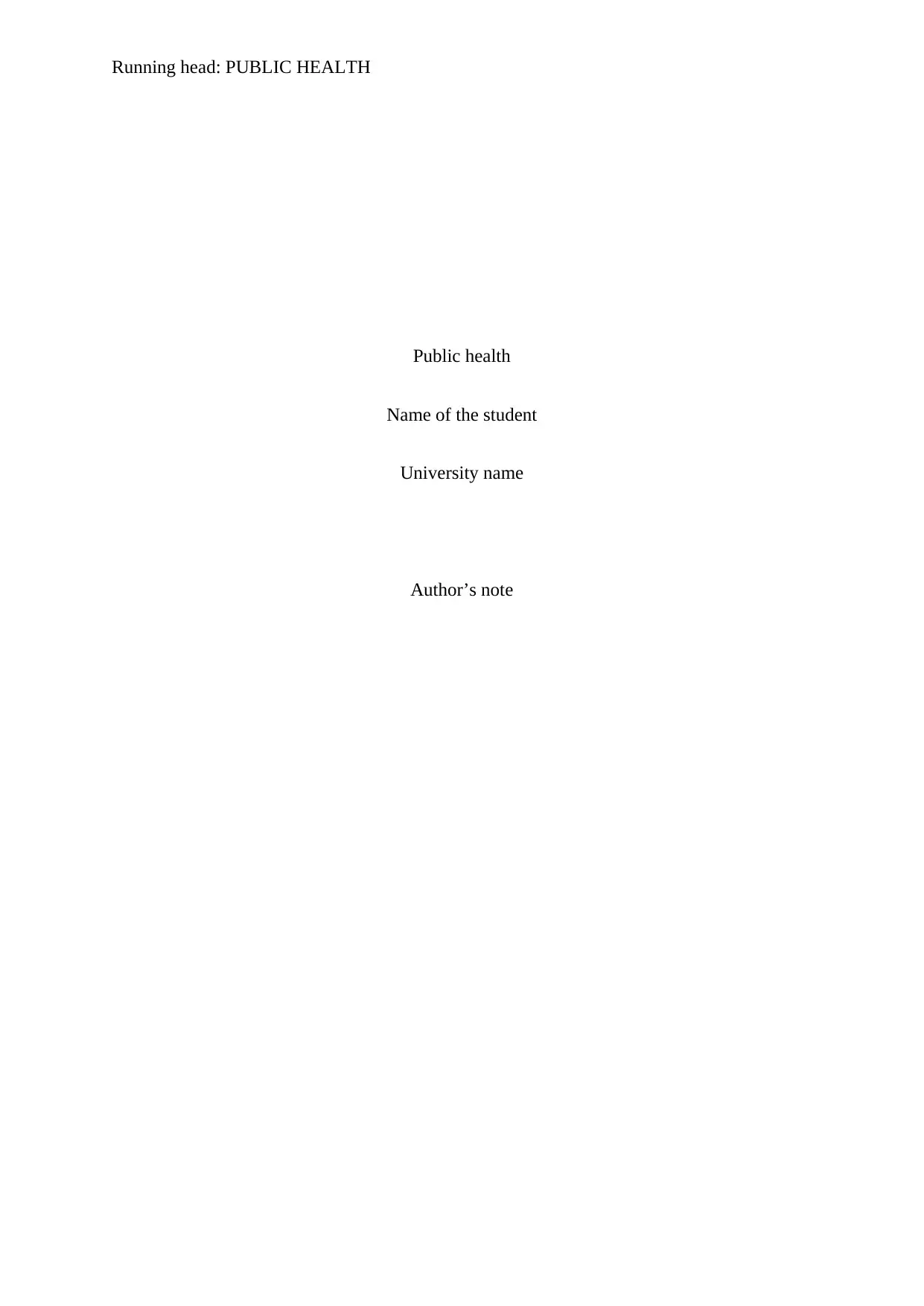
Running head: PUBLIC HEALTH
Public health
Name of the student
University name
Author’s note
Public health
Name of the student
University name
Author’s note
Paraphrase This Document
Need a fresh take? Get an instant paraphrase of this document with our AI Paraphraser
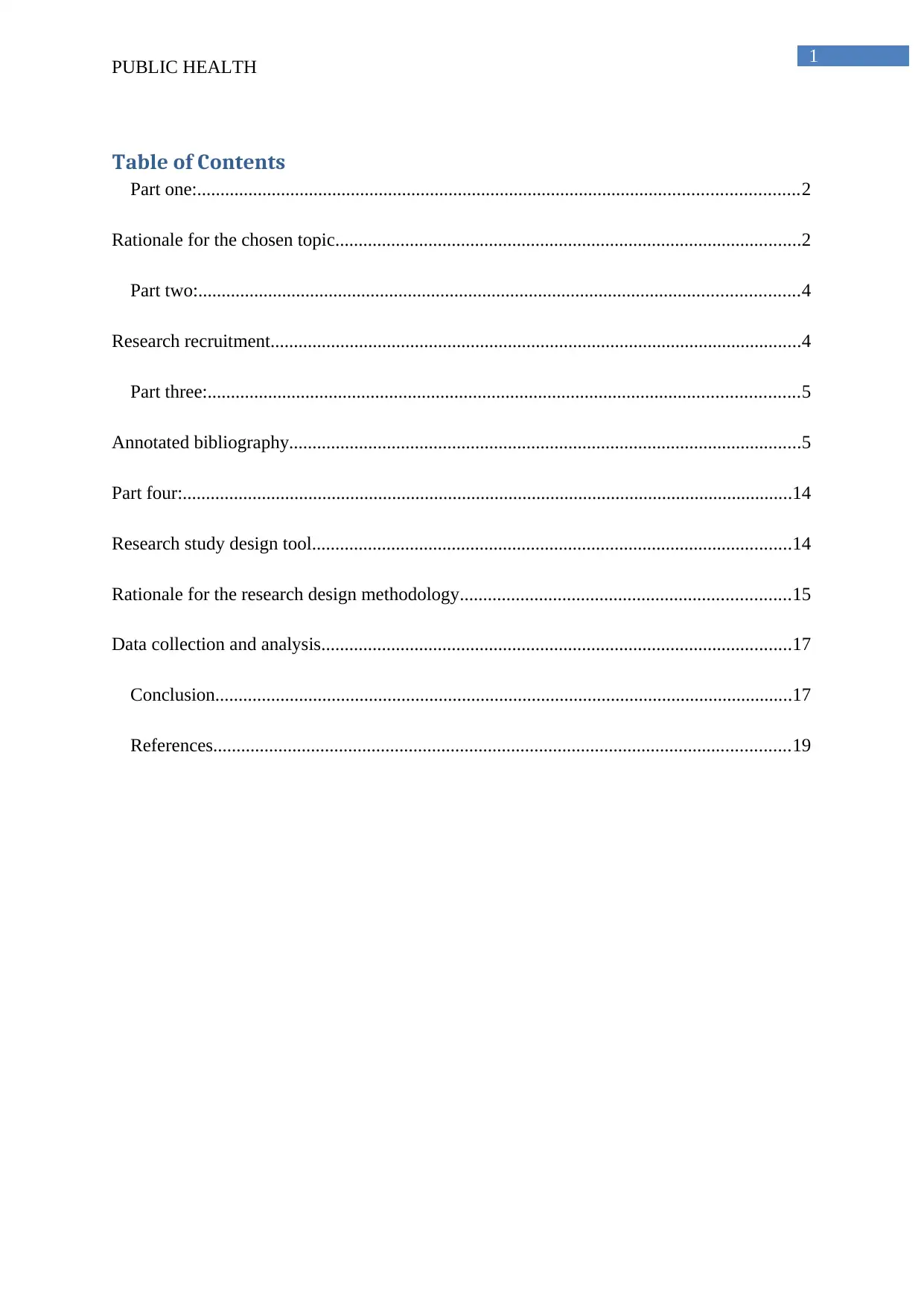
1
PUBLIC HEALTH
Table of Contents
Part one:.................................................................................................................................2
Rationale for the chosen topic....................................................................................................2
Part two:.................................................................................................................................4
Research recruitment..................................................................................................................4
Part three:...............................................................................................................................5
Annotated bibliography..............................................................................................................5
Part four:...................................................................................................................................14
Research study design tool.......................................................................................................14
Rationale for the research design methodology.......................................................................15
Data collection and analysis.....................................................................................................17
Conclusion............................................................................................................................17
References............................................................................................................................19
PUBLIC HEALTH
Table of Contents
Part one:.................................................................................................................................2
Rationale for the chosen topic....................................................................................................2
Part two:.................................................................................................................................4
Research recruitment..................................................................................................................4
Part three:...............................................................................................................................5
Annotated bibliography..............................................................................................................5
Part four:...................................................................................................................................14
Research study design tool.......................................................................................................14
Rationale for the research design methodology.......................................................................15
Data collection and analysis.....................................................................................................17
Conclusion............................................................................................................................17
References............................................................................................................................19
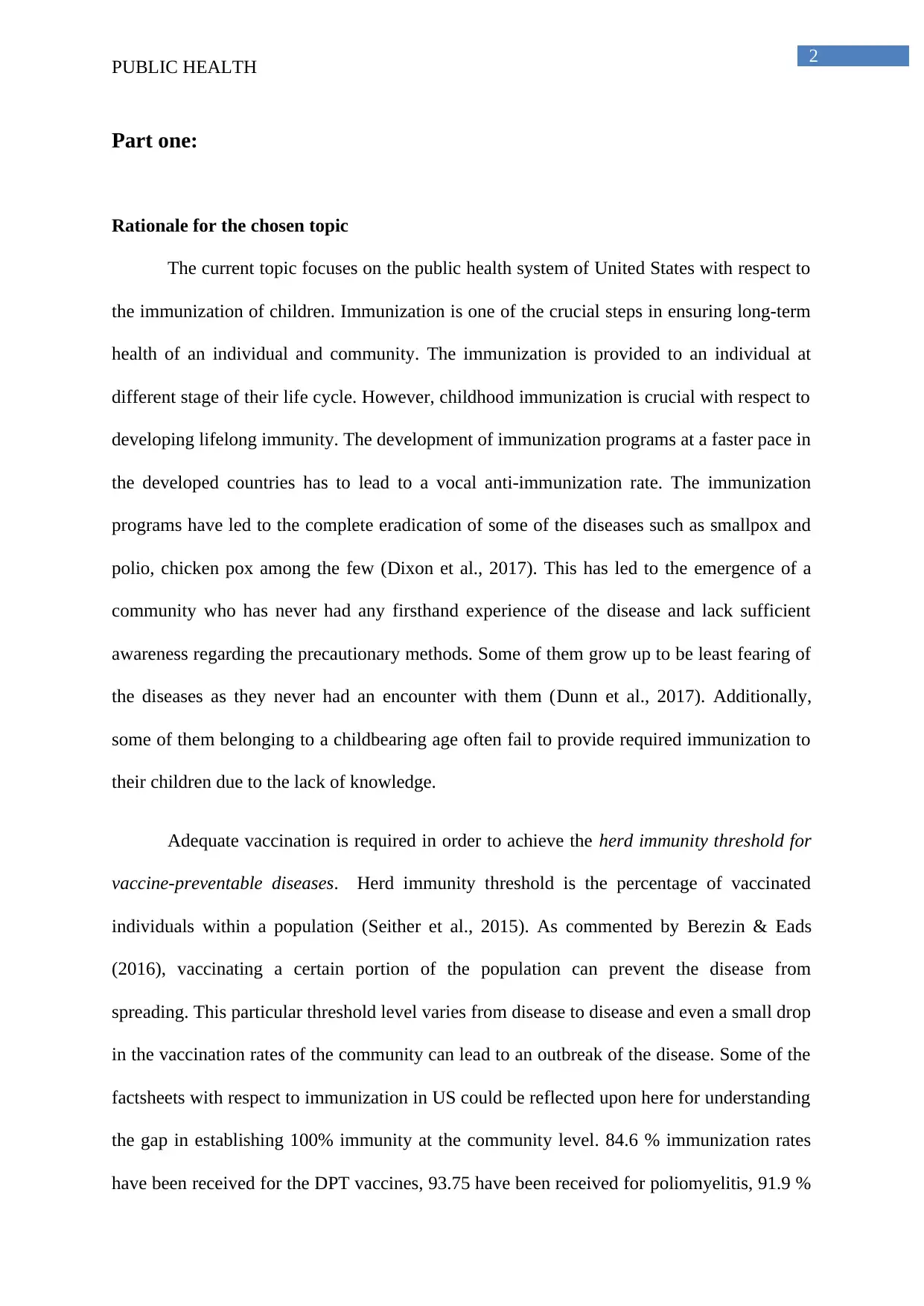
2
PUBLIC HEALTH
Part one:
Rationale for the chosen topic
The current topic focuses on the public health system of United States with respect to
the immunization of children. Immunization is one of the crucial steps in ensuring long-term
health of an individual and community. The immunization is provided to an individual at
different stage of their life cycle. However, childhood immunization is crucial with respect to
developing lifelong immunity. The development of immunization programs at a faster pace in
the developed countries has to lead to a vocal anti-immunization rate. The immunization
programs have led to the complete eradication of some of the diseases such as smallpox and
polio, chicken pox among the few (Dixon et al., 2017). This has led to the emergence of a
community who has never had any firsthand experience of the disease and lack sufficient
awareness regarding the precautionary methods. Some of them grow up to be least fearing of
the diseases as they never had an encounter with them (Dunn et al., 2017). Additionally,
some of them belonging to a childbearing age often fail to provide required immunization to
their children due to the lack of knowledge.
Adequate vaccination is required in order to achieve the herd immunity threshold for
vaccine-preventable diseases. Herd immunity threshold is the percentage of vaccinated
individuals within a population (Seither et al., 2015). As commented by Berezin & Eads
(2016), vaccinating a certain portion of the population can prevent the disease from
spreading. This particular threshold level varies from disease to disease and even a small drop
in the vaccination rates of the community can lead to an outbreak of the disease. Some of the
factsheets with respect to immunization in US could be reflected upon here for understanding
the gap in establishing 100% immunity at the community level. 84.6 % immunization rates
have been received for the DPT vaccines, 93.75 have been received for poliomyelitis, 91.9 %
PUBLIC HEALTH
Part one:
Rationale for the chosen topic
The current topic focuses on the public health system of United States with respect to
the immunization of children. Immunization is one of the crucial steps in ensuring long-term
health of an individual and community. The immunization is provided to an individual at
different stage of their life cycle. However, childhood immunization is crucial with respect to
developing lifelong immunity. The development of immunization programs at a faster pace in
the developed countries has to lead to a vocal anti-immunization rate. The immunization
programs have led to the complete eradication of some of the diseases such as smallpox and
polio, chicken pox among the few (Dixon et al., 2017). This has led to the emergence of a
community who has never had any firsthand experience of the disease and lack sufficient
awareness regarding the precautionary methods. Some of them grow up to be least fearing of
the diseases as they never had an encounter with them (Dunn et al., 2017). Additionally,
some of them belonging to a childbearing age often fail to provide required immunization to
their children due to the lack of knowledge.
Adequate vaccination is required in order to achieve the herd immunity threshold for
vaccine-preventable diseases. Herd immunity threshold is the percentage of vaccinated
individuals within a population (Seither et al., 2015). As commented by Berezin & Eads
(2016), vaccinating a certain portion of the population can prevent the disease from
spreading. This particular threshold level varies from disease to disease and even a small drop
in the vaccination rates of the community can lead to an outbreak of the disease. Some of the
factsheets with respect to immunization in US could be reflected upon here for understanding
the gap in establishing 100% immunity at the community level. 84.6 % immunization rates
have been received for the DPT vaccines, 93.75 have been received for poliomyelitis, 91.9 %
⊘ This is a preview!⊘
Do you want full access?
Subscribe today to unlock all pages.

Trusted by 1+ million students worldwide
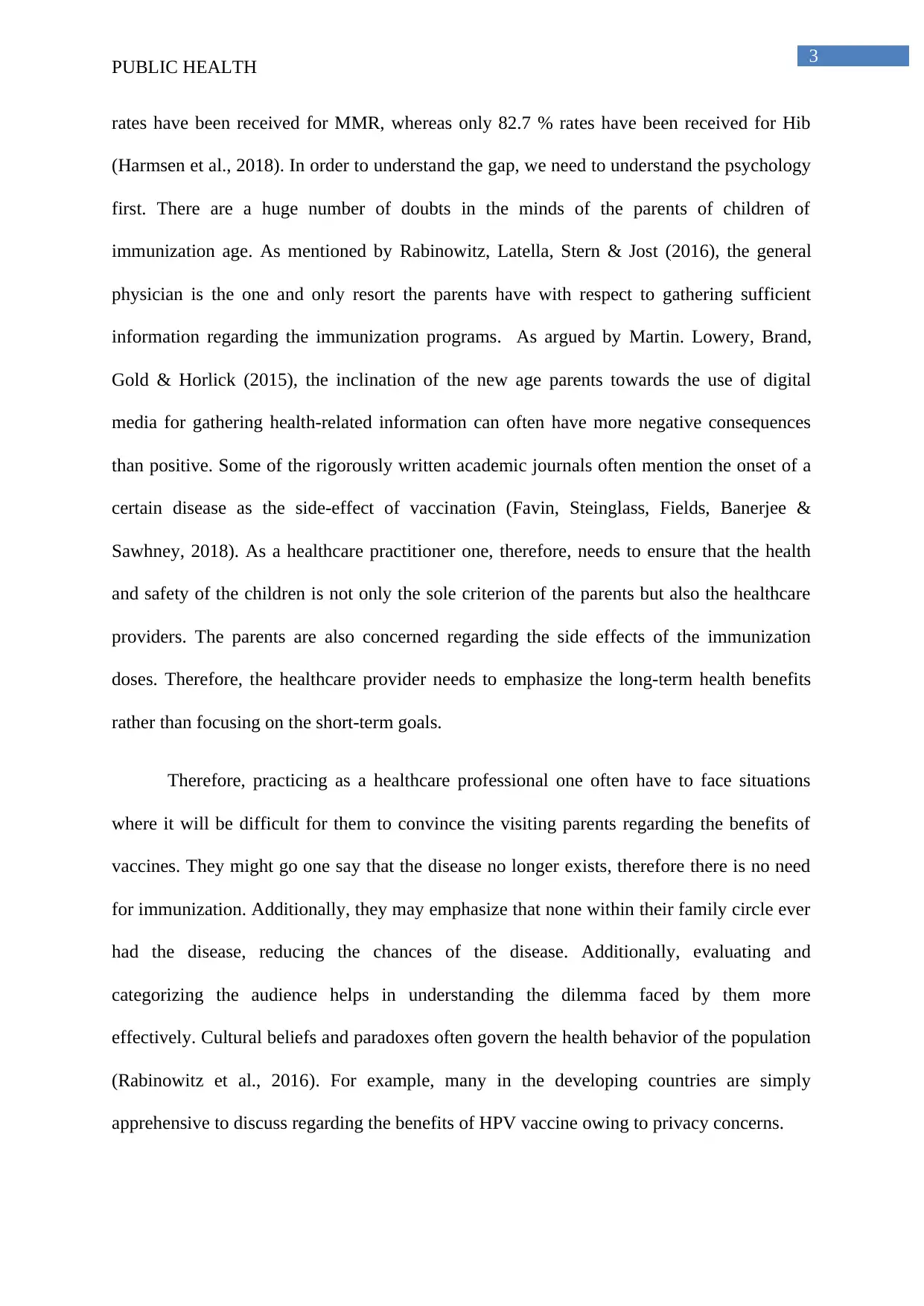
3
PUBLIC HEALTH
rates have been received for MMR, whereas only 82.7 % rates have been received for Hib
(Harmsen et al., 2018). In order to understand the gap, we need to understand the psychology
first. There are a huge number of doubts in the minds of the parents of children of
immunization age. As mentioned by Rabinowitz, Latella, Stern & Jost (2016), the general
physician is the one and only resort the parents have with respect to gathering sufficient
information regarding the immunization programs. As argued by Martin. Lowery, Brand,
Gold & Horlick (2015), the inclination of the new age parents towards the use of digital
media for gathering health-related information can often have more negative consequences
than positive. Some of the rigorously written academic journals often mention the onset of a
certain disease as the side-effect of vaccination (Favin, Steinglass, Fields, Banerjee &
Sawhney, 2018). As a healthcare practitioner one, therefore, needs to ensure that the health
and safety of the children is not only the sole criterion of the parents but also the healthcare
providers. The parents are also concerned regarding the side effects of the immunization
doses. Therefore, the healthcare provider needs to emphasize the long-term health benefits
rather than focusing on the short-term goals.
Therefore, practicing as a healthcare professional one often have to face situations
where it will be difficult for them to convince the visiting parents regarding the benefits of
vaccines. They might go one say that the disease no longer exists, therefore there is no need
for immunization. Additionally, they may emphasize that none within their family circle ever
had the disease, reducing the chances of the disease. Additionally, evaluating and
categorizing the audience helps in understanding the dilemma faced by them more
effectively. Cultural beliefs and paradoxes often govern the health behavior of the population
(Rabinowitz et al., 2016). For example, many in the developing countries are simply
apprehensive to discuss regarding the benefits of HPV vaccine owing to privacy concerns.
PUBLIC HEALTH
rates have been received for MMR, whereas only 82.7 % rates have been received for Hib
(Harmsen et al., 2018). In order to understand the gap, we need to understand the psychology
first. There are a huge number of doubts in the minds of the parents of children of
immunization age. As mentioned by Rabinowitz, Latella, Stern & Jost (2016), the general
physician is the one and only resort the parents have with respect to gathering sufficient
information regarding the immunization programs. As argued by Martin. Lowery, Brand,
Gold & Horlick (2015), the inclination of the new age parents towards the use of digital
media for gathering health-related information can often have more negative consequences
than positive. Some of the rigorously written academic journals often mention the onset of a
certain disease as the side-effect of vaccination (Favin, Steinglass, Fields, Banerjee &
Sawhney, 2018). As a healthcare practitioner one, therefore, needs to ensure that the health
and safety of the children is not only the sole criterion of the parents but also the healthcare
providers. The parents are also concerned regarding the side effects of the immunization
doses. Therefore, the healthcare provider needs to emphasize the long-term health benefits
rather than focusing on the short-term goals.
Therefore, practicing as a healthcare professional one often have to face situations
where it will be difficult for them to convince the visiting parents regarding the benefits of
vaccines. They might go one say that the disease no longer exists, therefore there is no need
for immunization. Additionally, they may emphasize that none within their family circle ever
had the disease, reducing the chances of the disease. Additionally, evaluating and
categorizing the audience helps in understanding the dilemma faced by them more
effectively. Cultural beliefs and paradoxes often govern the health behavior of the population
(Rabinowitz et al., 2016). For example, many in the developing countries are simply
apprehensive to discuss regarding the benefits of HPV vaccine owing to privacy concerns.
Paraphrase This Document
Need a fresh take? Get an instant paraphrase of this document with our AI Paraphraser
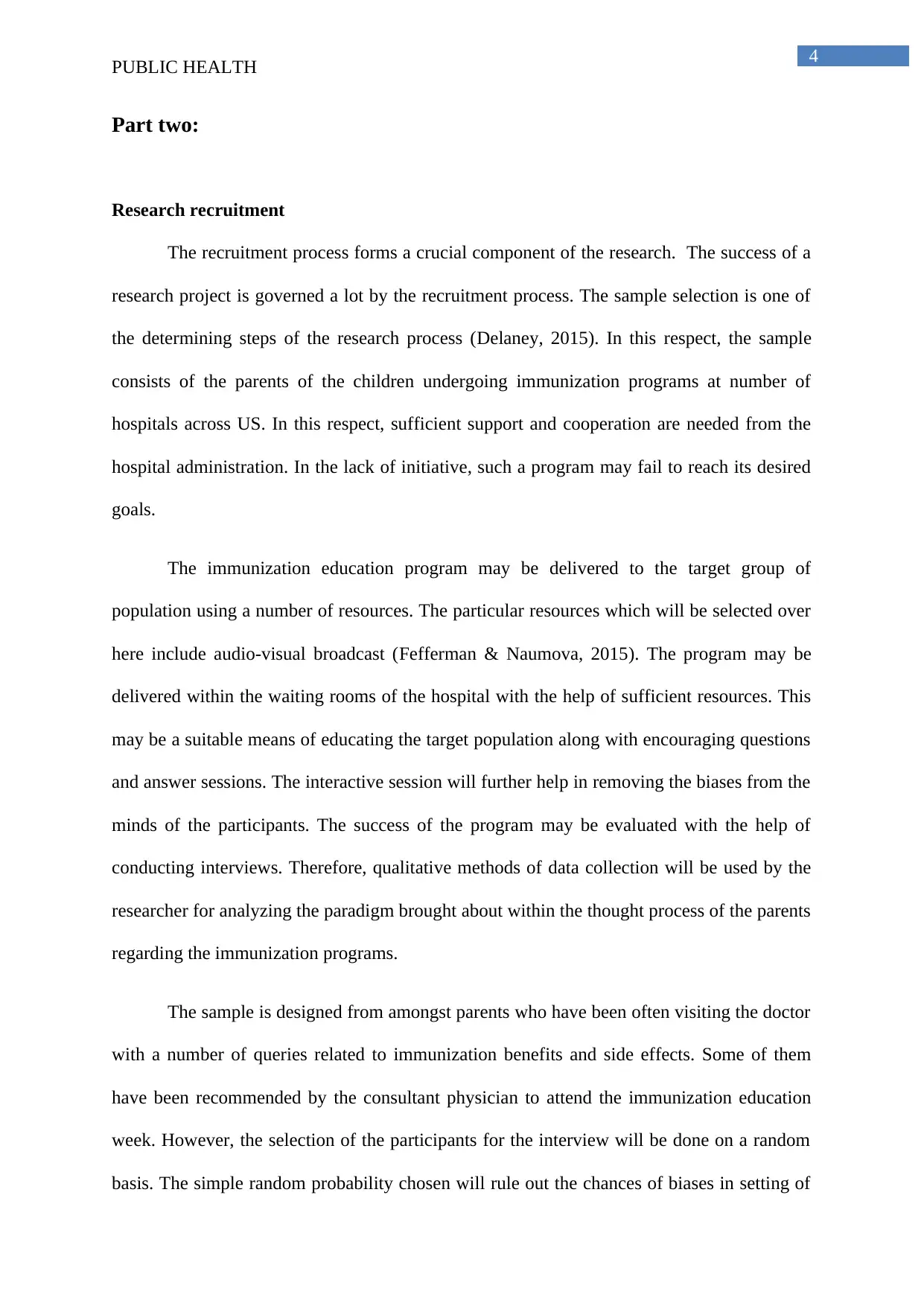
4
PUBLIC HEALTH
Part two:
Research recruitment
The recruitment process forms a crucial component of the research. The success of a
research project is governed a lot by the recruitment process. The sample selection is one of
the determining steps of the research process (Delaney, 2015). In this respect, the sample
consists of the parents of the children undergoing immunization programs at number of
hospitals across US. In this respect, sufficient support and cooperation are needed from the
hospital administration. In the lack of initiative, such a program may fail to reach its desired
goals.
The immunization education program may be delivered to the target group of
population using a number of resources. The particular resources which will be selected over
here include audio-visual broadcast (Fefferman & Naumova, 2015). The program may be
delivered within the waiting rooms of the hospital with the help of sufficient resources. This
may be a suitable means of educating the target population along with encouraging questions
and answer sessions. The interactive session will further help in removing the biases from the
minds of the participants. The success of the program may be evaluated with the help of
conducting interviews. Therefore, qualitative methods of data collection will be used by the
researcher for analyzing the paradigm brought about within the thought process of the parents
regarding the immunization programs.
The sample is designed from amongst parents who have been often visiting the doctor
with a number of queries related to immunization benefits and side effects. Some of them
have been recommended by the consultant physician to attend the immunization education
week. However, the selection of the participants for the interview will be done on a random
basis. The simple random probability chosen will rule out the chances of biases in setting of
PUBLIC HEALTH
Part two:
Research recruitment
The recruitment process forms a crucial component of the research. The success of a
research project is governed a lot by the recruitment process. The sample selection is one of
the determining steps of the research process (Delaney, 2015). In this respect, the sample
consists of the parents of the children undergoing immunization programs at number of
hospitals across US. In this respect, sufficient support and cooperation are needed from the
hospital administration. In the lack of initiative, such a program may fail to reach its desired
goals.
The immunization education program may be delivered to the target group of
population using a number of resources. The particular resources which will be selected over
here include audio-visual broadcast (Fefferman & Naumova, 2015). The program may be
delivered within the waiting rooms of the hospital with the help of sufficient resources. This
may be a suitable means of educating the target population along with encouraging questions
and answer sessions. The interactive session will further help in removing the biases from the
minds of the participants. The success of the program may be evaluated with the help of
conducting interviews. Therefore, qualitative methods of data collection will be used by the
researcher for analyzing the paradigm brought about within the thought process of the parents
regarding the immunization programs.
The sample is designed from amongst parents who have been often visiting the doctor
with a number of queries related to immunization benefits and side effects. Some of them
have been recommended by the consultant physician to attend the immunization education
week. However, the selection of the participants for the interview will be done on a random
basis. The simple random probability chosen will rule out the chances of biases in setting of
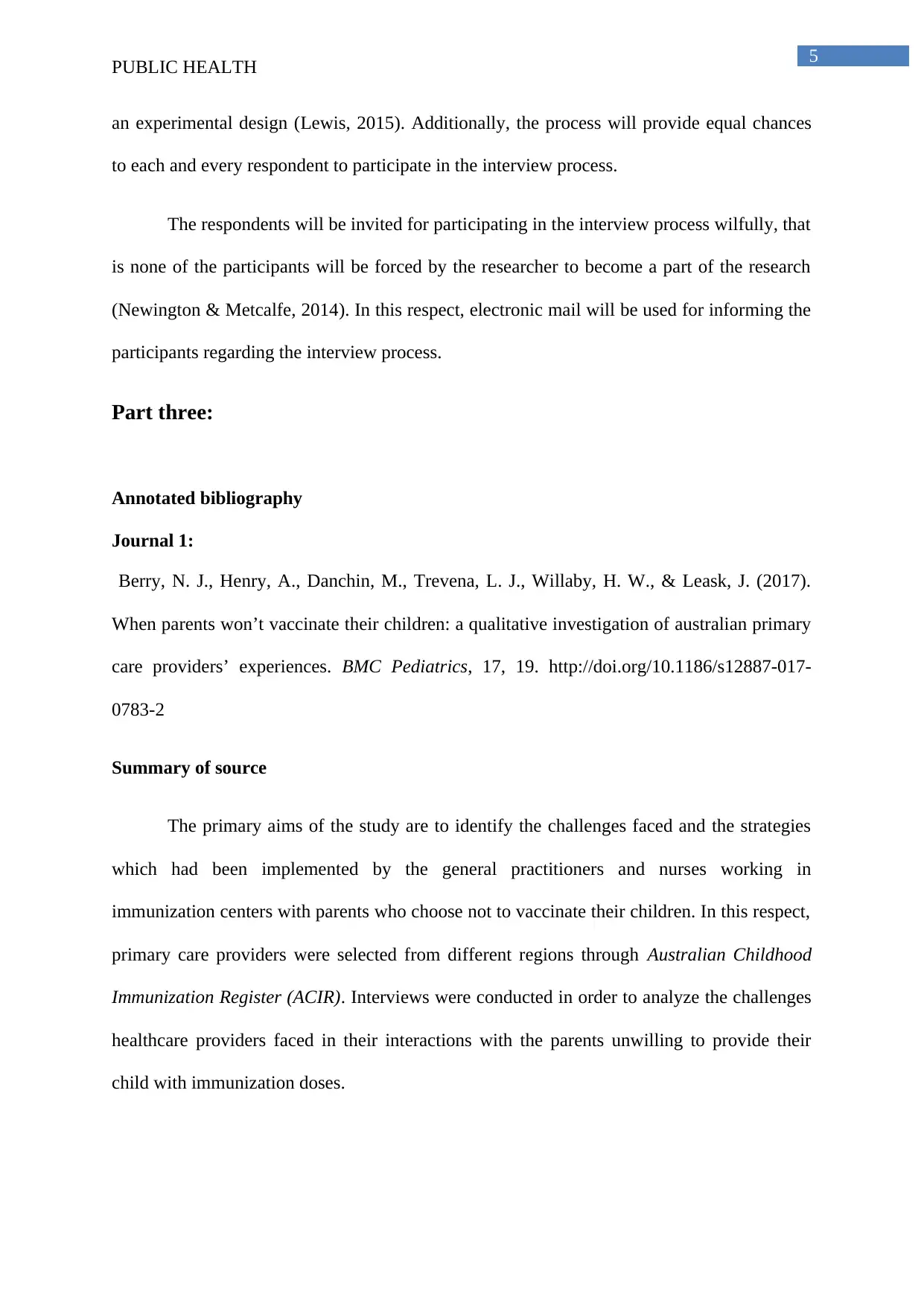
5
PUBLIC HEALTH
an experimental design (Lewis, 2015). Additionally, the process will provide equal chances
to each and every respondent to participate in the interview process.
The respondents will be invited for participating in the interview process wilfully, that
is none of the participants will be forced by the researcher to become a part of the research
(Newington & Metcalfe, 2014). In this respect, electronic mail will be used for informing the
participants regarding the interview process.
Part three:
Annotated bibliography
Journal 1:
Berry, N. J., Henry, A., Danchin, M., Trevena, L. J., Willaby, H. W., & Leask, J. (2017).
When parents won’t vaccinate their children: a qualitative investigation of australian primary
care providers’ experiences. BMC Pediatrics, 17, 19. http://doi.org/10.1186/s12887-017-
0783-2
Summary of source
The primary aims of the study are to identify the challenges faced and the strategies
which had been implemented by the general practitioners and nurses working in
immunization centers with parents who choose not to vaccinate their children. In this respect,
primary care providers were selected from different regions through Australian Childhood
Immunization Register (ACIR). Interviews were conducted in order to analyze the challenges
healthcare providers faced in their interactions with the parents unwilling to provide their
child with immunization doses.
PUBLIC HEALTH
an experimental design (Lewis, 2015). Additionally, the process will provide equal chances
to each and every respondent to participate in the interview process.
The respondents will be invited for participating in the interview process wilfully, that
is none of the participants will be forced by the researcher to become a part of the research
(Newington & Metcalfe, 2014). In this respect, electronic mail will be used for informing the
participants regarding the interview process.
Part three:
Annotated bibliography
Journal 1:
Berry, N. J., Henry, A., Danchin, M., Trevena, L. J., Willaby, H. W., & Leask, J. (2017).
When parents won’t vaccinate their children: a qualitative investigation of australian primary
care providers’ experiences. BMC Pediatrics, 17, 19. http://doi.org/10.1186/s12887-017-
0783-2
Summary of source
The primary aims of the study are to identify the challenges faced and the strategies
which had been implemented by the general practitioners and nurses working in
immunization centers with parents who choose not to vaccinate their children. In this respect,
primary care providers were selected from different regions through Australian Childhood
Immunization Register (ACIR). Interviews were conducted in order to analyze the challenges
healthcare providers faced in their interactions with the parents unwilling to provide their
child with immunization doses.
⊘ This is a preview!⊘
Do you want full access?
Subscribe today to unlock all pages.

Trusted by 1+ million students worldwide
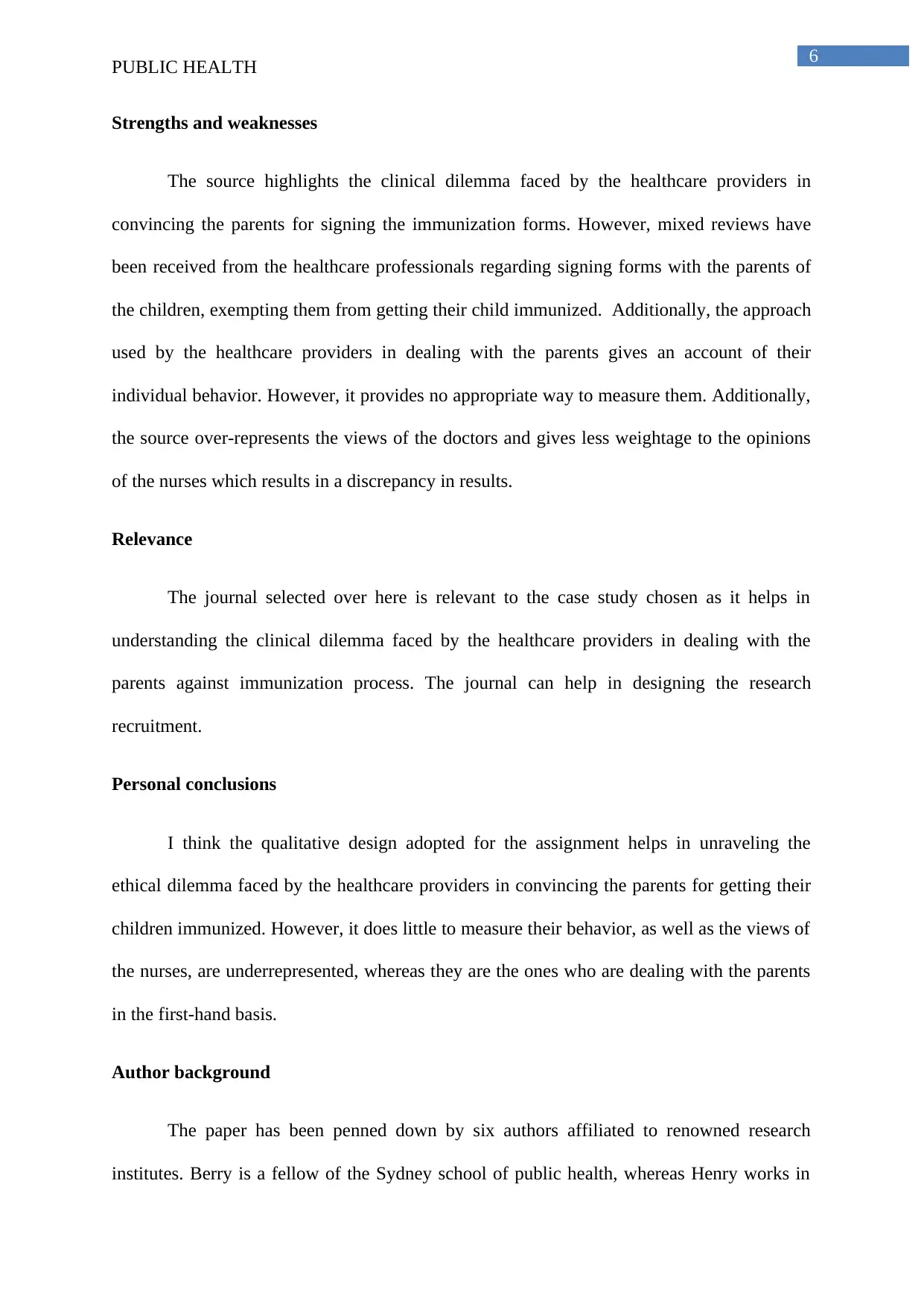
6
PUBLIC HEALTH
Strengths and weaknesses
The source highlights the clinical dilemma faced by the healthcare providers in
convincing the parents for signing the immunization forms. However, mixed reviews have
been received from the healthcare professionals regarding signing forms with the parents of
the children, exempting them from getting their child immunized. Additionally, the approach
used by the healthcare providers in dealing with the parents gives an account of their
individual behavior. However, it provides no appropriate way to measure them. Additionally,
the source over-represents the views of the doctors and gives less weightage to the opinions
of the nurses which results in a discrepancy in results.
Relevance
The journal selected over here is relevant to the case study chosen as it helps in
understanding the clinical dilemma faced by the healthcare providers in dealing with the
parents against immunization process. The journal can help in designing the research
recruitment.
Personal conclusions
I think the qualitative design adopted for the assignment helps in unraveling the
ethical dilemma faced by the healthcare providers in convincing the parents for getting their
children immunized. However, it does little to measure their behavior, as well as the views of
the nurses, are underrepresented, whereas they are the ones who are dealing with the parents
in the first-hand basis.
Author background
The paper has been penned down by six authors affiliated to renowned research
institutes. Berry is a fellow of the Sydney school of public health, whereas Henry works in
PUBLIC HEALTH
Strengths and weaknesses
The source highlights the clinical dilemma faced by the healthcare providers in
convincing the parents for signing the immunization forms. However, mixed reviews have
been received from the healthcare professionals regarding signing forms with the parents of
the children, exempting them from getting their child immunized. Additionally, the approach
used by the healthcare providers in dealing with the parents gives an account of their
individual behavior. However, it provides no appropriate way to measure them. Additionally,
the source over-represents the views of the doctors and gives less weightage to the opinions
of the nurses which results in a discrepancy in results.
Relevance
The journal selected over here is relevant to the case study chosen as it helps in
understanding the clinical dilemma faced by the healthcare providers in dealing with the
parents against immunization process. The journal can help in designing the research
recruitment.
Personal conclusions
I think the qualitative design adopted for the assignment helps in unraveling the
ethical dilemma faced by the healthcare providers in convincing the parents for getting their
children immunized. However, it does little to measure their behavior, as well as the views of
the nurses, are underrepresented, whereas they are the ones who are dealing with the parents
in the first-hand basis.
Author background
The paper has been penned down by six authors affiliated to renowned research
institutes. Berry is a fellow of the Sydney school of public health, whereas Henry works in
Paraphrase This Document
Need a fresh take? Get an instant paraphrase of this document with our AI Paraphraser
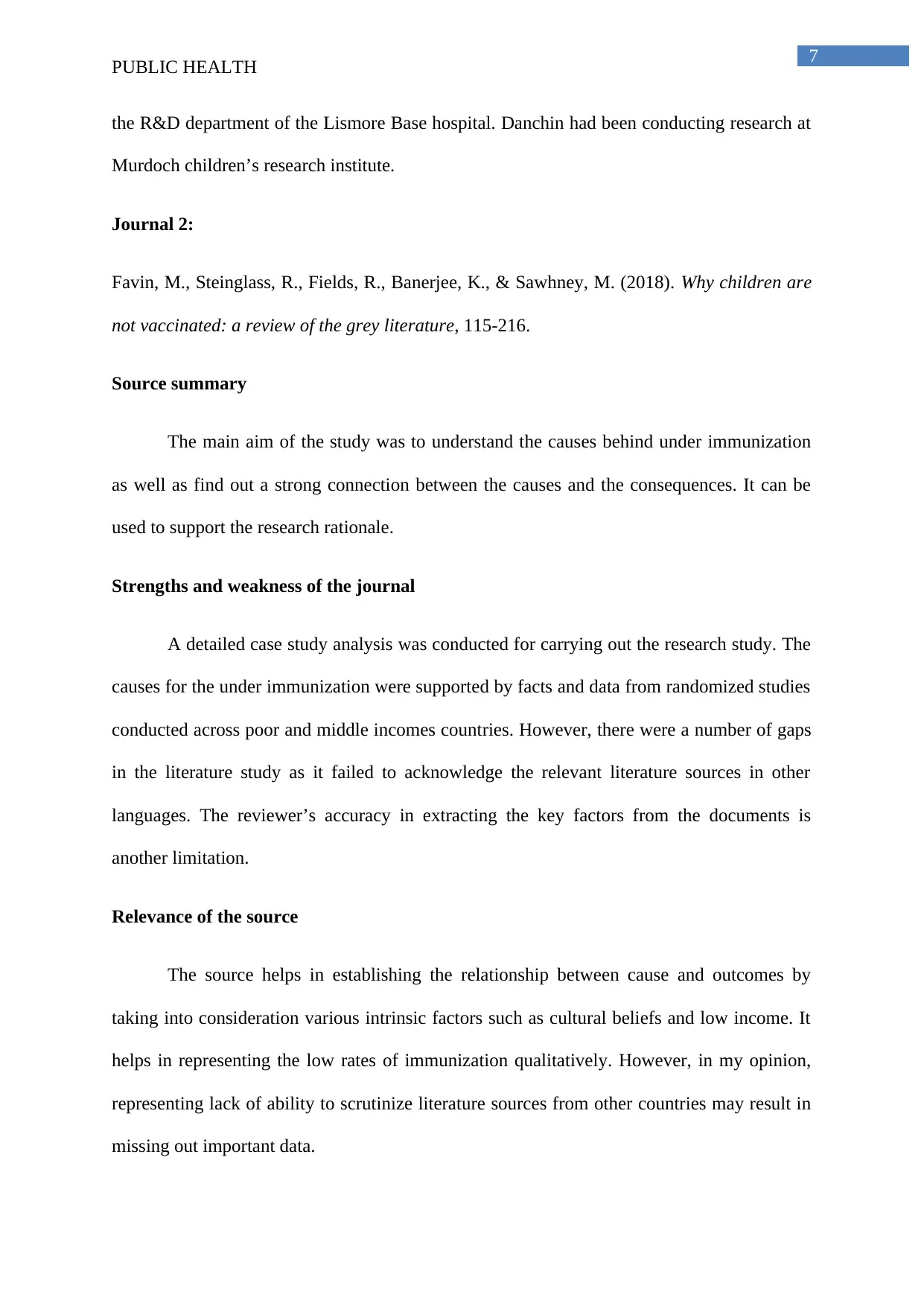
7
PUBLIC HEALTH
the R&D department of the Lismore Base hospital. Danchin had been conducting research at
Murdoch children’s research institute.
Journal 2:
Favin, M., Steinglass, R., Fields, R., Banerjee, K., & Sawhney, M. (2018). Why children are
not vaccinated: a review of the grey literature, 115-216.
Source summary
The main aim of the study was to understand the causes behind under immunization
as well as find out a strong connection between the causes and the consequences. It can be
used to support the research rationale.
Strengths and weakness of the journal
A detailed case study analysis was conducted for carrying out the research study. The
causes for the under immunization were supported by facts and data from randomized studies
conducted across poor and middle incomes countries. However, there were a number of gaps
in the literature study as it failed to acknowledge the relevant literature sources in other
languages. The reviewer’s accuracy in extracting the key factors from the documents is
another limitation.
Relevance of the source
The source helps in establishing the relationship between cause and outcomes by
taking into consideration various intrinsic factors such as cultural beliefs and low income. It
helps in representing the low rates of immunization qualitatively. However, in my opinion,
representing lack of ability to scrutinize literature sources from other countries may result in
missing out important data.
PUBLIC HEALTH
the R&D department of the Lismore Base hospital. Danchin had been conducting research at
Murdoch children’s research institute.
Journal 2:
Favin, M., Steinglass, R., Fields, R., Banerjee, K., & Sawhney, M. (2018). Why children are
not vaccinated: a review of the grey literature, 115-216.
Source summary
The main aim of the study was to understand the causes behind under immunization
as well as find out a strong connection between the causes and the consequences. It can be
used to support the research rationale.
Strengths and weakness of the journal
A detailed case study analysis was conducted for carrying out the research study. The
causes for the under immunization were supported by facts and data from randomized studies
conducted across poor and middle incomes countries. However, there were a number of gaps
in the literature study as it failed to acknowledge the relevant literature sources in other
languages. The reviewer’s accuracy in extracting the key factors from the documents is
another limitation.
Relevance of the source
The source helps in establishing the relationship between cause and outcomes by
taking into consideration various intrinsic factors such as cultural beliefs and low income. It
helps in representing the low rates of immunization qualitatively. However, in my opinion,
representing lack of ability to scrutinize literature sources from other countries may result in
missing out important data.
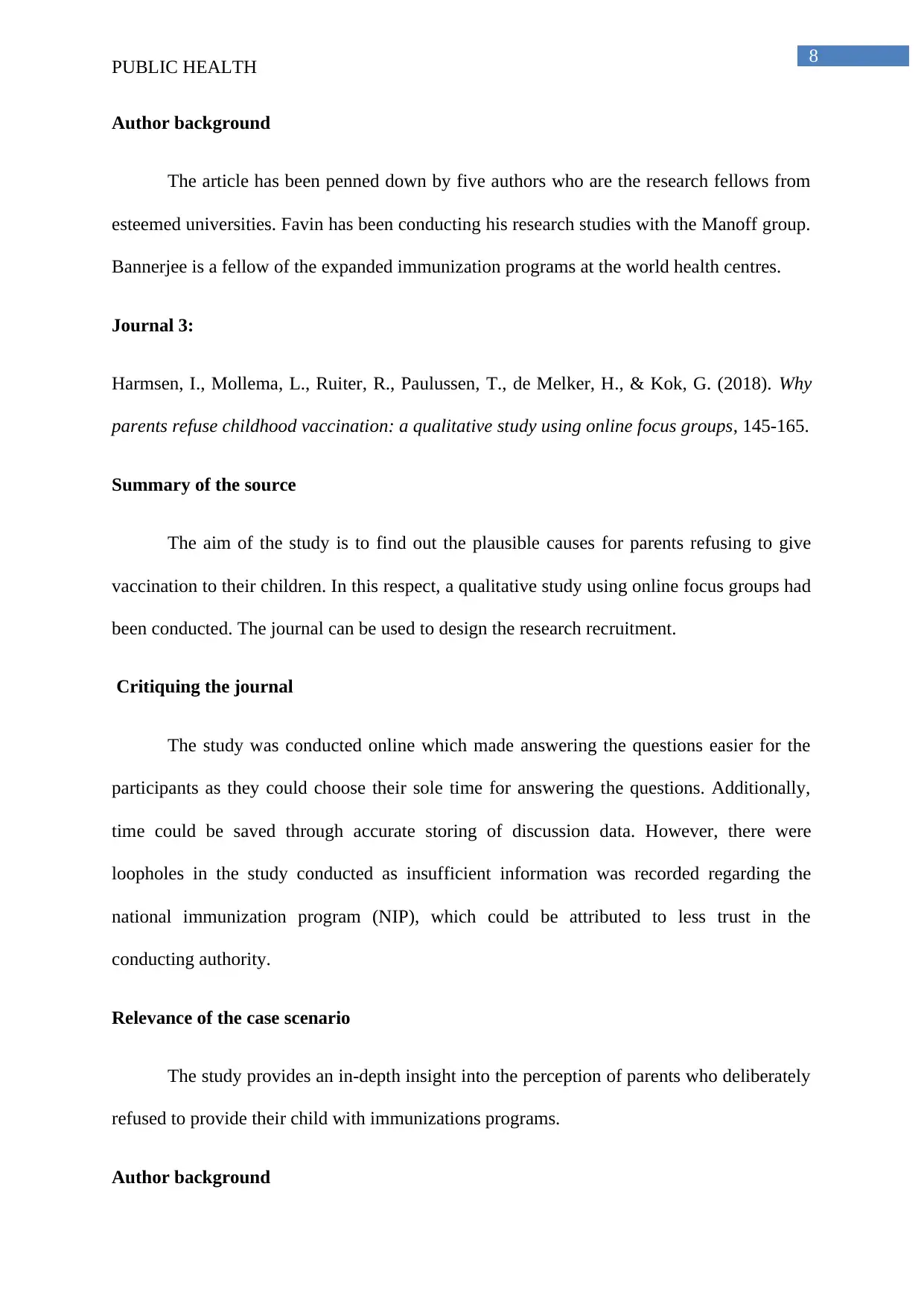
8
PUBLIC HEALTH
Author background
The article has been penned down by five authors who are the research fellows from
esteemed universities. Favin has been conducting his research studies with the Manoff group.
Bannerjee is a fellow of the expanded immunization programs at the world health centres.
Journal 3:
Harmsen, I., Mollema, L., Ruiter, R., Paulussen, T., de Melker, H., & Kok, G. (2018). Why
parents refuse childhood vaccination: a qualitative study using online focus groups, 145-165.
Summary of the source
The aim of the study is to find out the plausible causes for parents refusing to give
vaccination to their children. In this respect, a qualitative study using online focus groups had
been conducted. The journal can be used to design the research recruitment.
Critiquing the journal
The study was conducted online which made answering the questions easier for the
participants as they could choose their sole time for answering the questions. Additionally,
time could be saved through accurate storing of discussion data. However, there were
loopholes in the study conducted as insufficient information was recorded regarding the
national immunization program (NIP), which could be attributed to less trust in the
conducting authority.
Relevance of the case scenario
The study provides an in-depth insight into the perception of parents who deliberately
refused to provide their child with immunizations programs.
Author background
PUBLIC HEALTH
Author background
The article has been penned down by five authors who are the research fellows from
esteemed universities. Favin has been conducting his research studies with the Manoff group.
Bannerjee is a fellow of the expanded immunization programs at the world health centres.
Journal 3:
Harmsen, I., Mollema, L., Ruiter, R., Paulussen, T., de Melker, H., & Kok, G. (2018). Why
parents refuse childhood vaccination: a qualitative study using online focus groups, 145-165.
Summary of the source
The aim of the study is to find out the plausible causes for parents refusing to give
vaccination to their children. In this respect, a qualitative study using online focus groups had
been conducted. The journal can be used to design the research recruitment.
Critiquing the journal
The study was conducted online which made answering the questions easier for the
participants as they could choose their sole time for answering the questions. Additionally,
time could be saved through accurate storing of discussion data. However, there were
loopholes in the study conducted as insufficient information was recorded regarding the
national immunization program (NIP), which could be attributed to less trust in the
conducting authority.
Relevance of the case scenario
The study provides an in-depth insight into the perception of parents who deliberately
refused to provide their child with immunizations programs.
Author background
⊘ This is a preview!⊘
Do you want full access?
Subscribe today to unlock all pages.

Trusted by 1+ million students worldwide
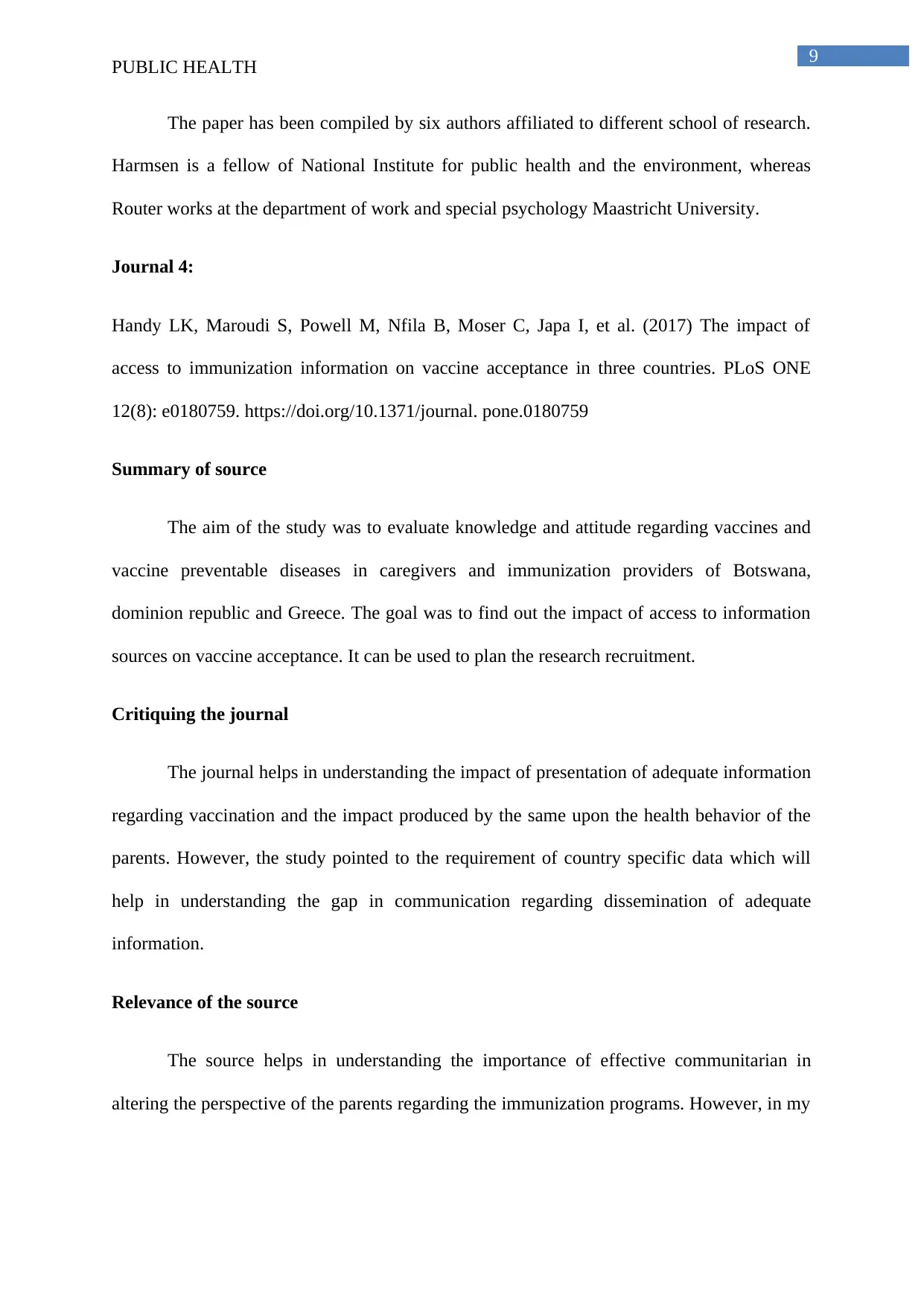
9
PUBLIC HEALTH
The paper has been compiled by six authors affiliated to different school of research.
Harmsen is a fellow of National Institute for public health and the environment, whereas
Router works at the department of work and special psychology Maastricht University.
Journal 4:
Handy LK, Maroudi S, Powell M, Nfila B, Moser C, Japa I, et al. (2017) The impact of
access to immunization information on vaccine acceptance in three countries. PLoS ONE
12(8): e0180759. https://doi.org/10.1371/journal. pone.0180759
Summary of source
The aim of the study was to evaluate knowledge and attitude regarding vaccines and
vaccine preventable diseases in caregivers and immunization providers of Botswana,
dominion republic and Greece. The goal was to find out the impact of access to information
sources on vaccine acceptance. It can be used to plan the research recruitment.
Critiquing the journal
The journal helps in understanding the impact of presentation of adequate information
regarding vaccination and the impact produced by the same upon the health behavior of the
parents. However, the study pointed to the requirement of country specific data which will
help in understanding the gap in communication regarding dissemination of adequate
information.
Relevance of the source
The source helps in understanding the importance of effective communitarian in
altering the perspective of the parents regarding the immunization programs. However, in my
PUBLIC HEALTH
The paper has been compiled by six authors affiliated to different school of research.
Harmsen is a fellow of National Institute for public health and the environment, whereas
Router works at the department of work and special psychology Maastricht University.
Journal 4:
Handy LK, Maroudi S, Powell M, Nfila B, Moser C, Japa I, et al. (2017) The impact of
access to immunization information on vaccine acceptance in three countries. PLoS ONE
12(8): e0180759. https://doi.org/10.1371/journal. pone.0180759
Summary of source
The aim of the study was to evaluate knowledge and attitude regarding vaccines and
vaccine preventable diseases in caregivers and immunization providers of Botswana,
dominion republic and Greece. The goal was to find out the impact of access to information
sources on vaccine acceptance. It can be used to plan the research recruitment.
Critiquing the journal
The journal helps in understanding the impact of presentation of adequate information
regarding vaccination and the impact produced by the same upon the health behavior of the
parents. However, the study pointed to the requirement of country specific data which will
help in understanding the gap in communication regarding dissemination of adequate
information.
Relevance of the source
The source helps in understanding the importance of effective communitarian in
altering the perspective of the parents regarding the immunization programs. However, in my
Paraphrase This Document
Need a fresh take? Get an instant paraphrase of this document with our AI Paraphraser
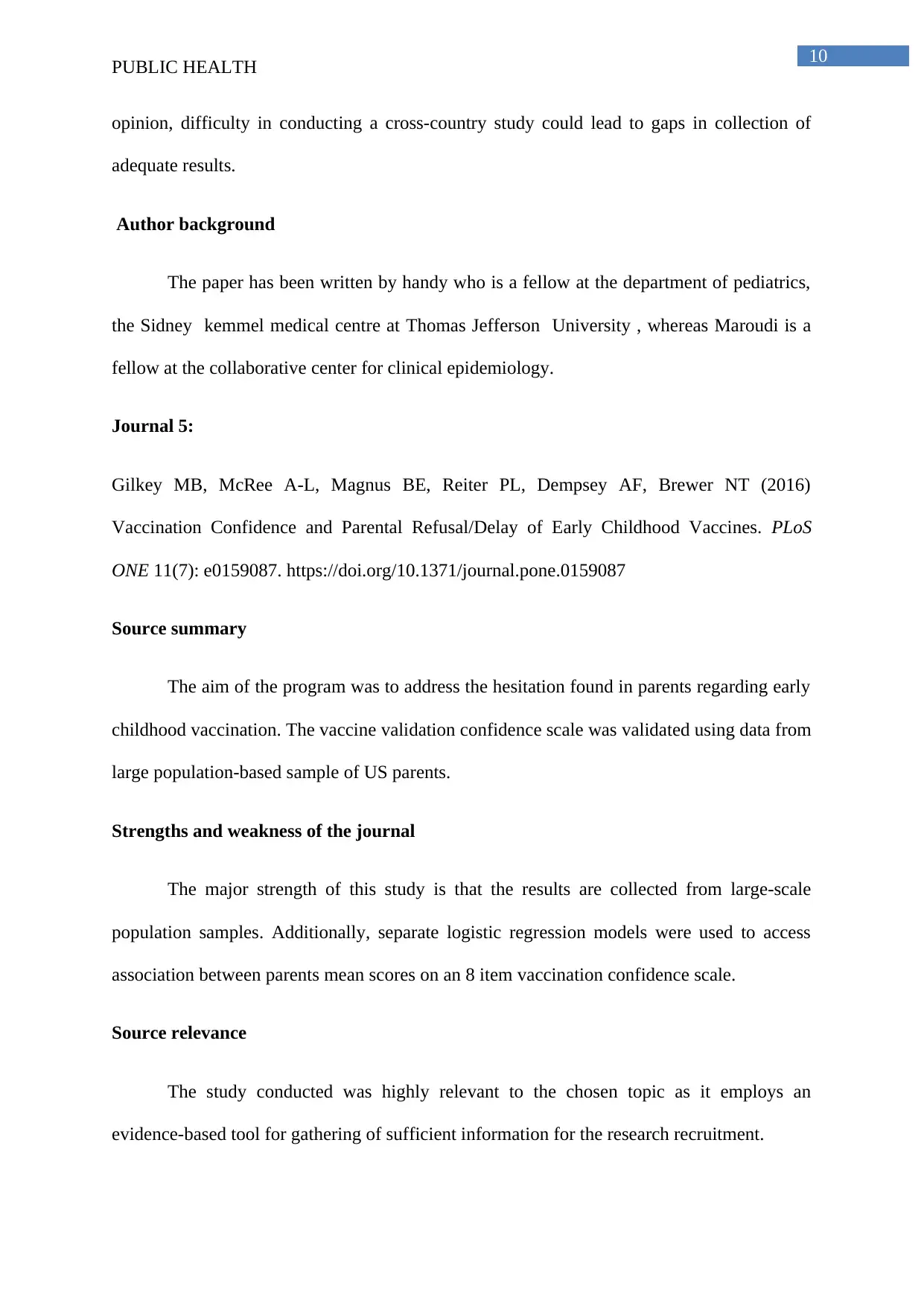
10
PUBLIC HEALTH
opinion, difficulty in conducting a cross-country study could lead to gaps in collection of
adequate results.
Author background
The paper has been written by handy who is a fellow at the department of pediatrics,
the Sidney kemmel medical centre at Thomas Jefferson University , whereas Maroudi is a
fellow at the collaborative center for clinical epidemiology.
Journal 5:
Gilkey MB, McRee A-L, Magnus BE, Reiter PL, Dempsey AF, Brewer NT (2016)
Vaccination Confidence and Parental Refusal/Delay of Early Childhood Vaccines. PLoS
ONE 11(7): e0159087. https://doi.org/10.1371/journal.pone.0159087
Source summary
The aim of the program was to address the hesitation found in parents regarding early
childhood vaccination. The vaccine validation confidence scale was validated using data from
large population-based sample of US parents.
Strengths and weakness of the journal
The major strength of this study is that the results are collected from large-scale
population samples. Additionally, separate logistic regression models were used to access
association between parents mean scores on an 8 item vaccination confidence scale.
Source relevance
The study conducted was highly relevant to the chosen topic as it employs an
evidence-based tool for gathering of sufficient information for the research recruitment.
PUBLIC HEALTH
opinion, difficulty in conducting a cross-country study could lead to gaps in collection of
adequate results.
Author background
The paper has been written by handy who is a fellow at the department of pediatrics,
the Sidney kemmel medical centre at Thomas Jefferson University , whereas Maroudi is a
fellow at the collaborative center for clinical epidemiology.
Journal 5:
Gilkey MB, McRee A-L, Magnus BE, Reiter PL, Dempsey AF, Brewer NT (2016)
Vaccination Confidence and Parental Refusal/Delay of Early Childhood Vaccines. PLoS
ONE 11(7): e0159087. https://doi.org/10.1371/journal.pone.0159087
Source summary
The aim of the program was to address the hesitation found in parents regarding early
childhood vaccination. The vaccine validation confidence scale was validated using data from
large population-based sample of US parents.
Strengths and weakness of the journal
The major strength of this study is that the results are collected from large-scale
population samples. Additionally, separate logistic regression models were used to access
association between parents mean scores on an 8 item vaccination confidence scale.
Source relevance
The study conducted was highly relevant to the chosen topic as it employs an
evidence-based tool for gathering of sufficient information for the research recruitment.
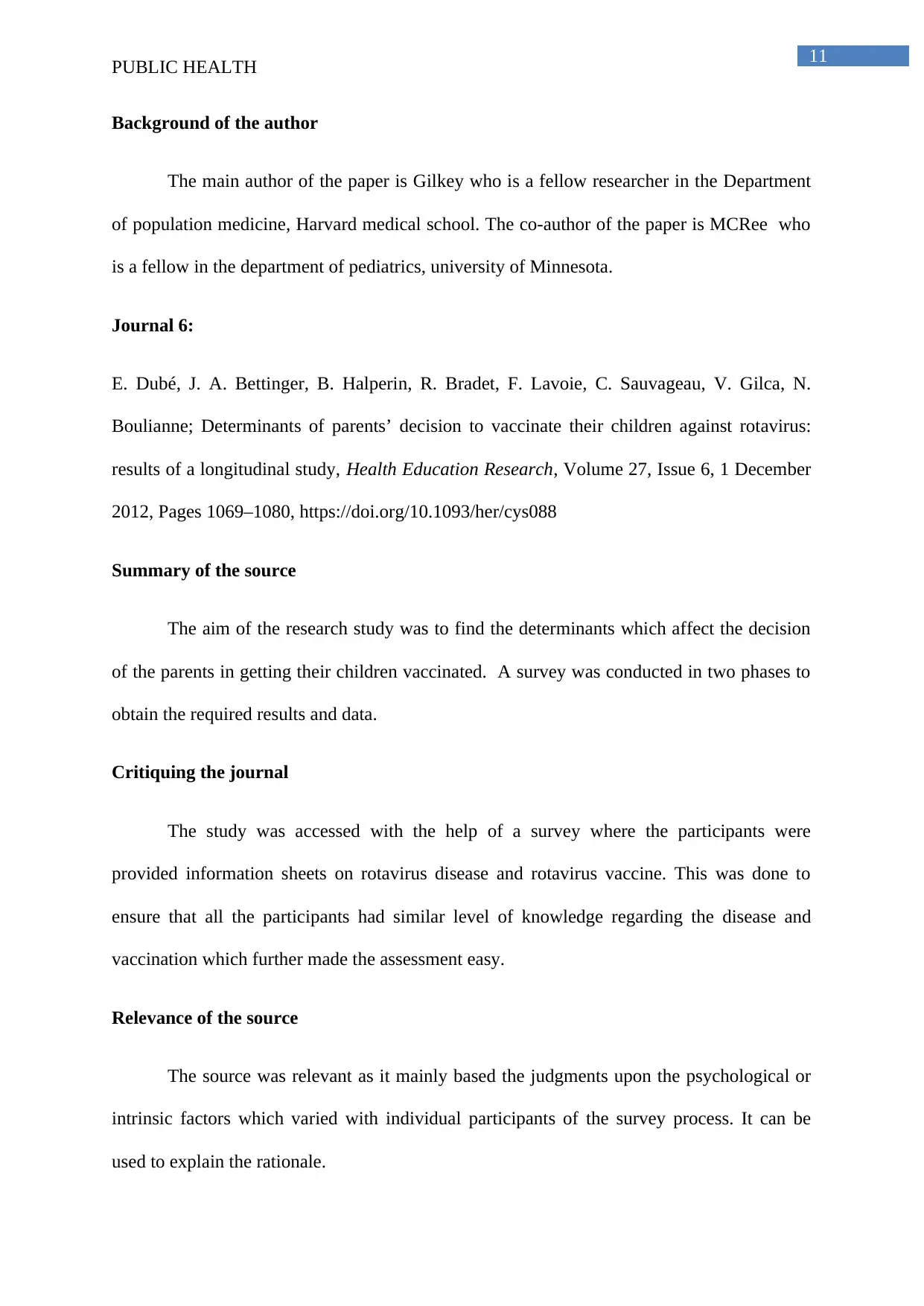
11
PUBLIC HEALTH
Background of the author
The main author of the paper is Gilkey who is a fellow researcher in the Department
of population medicine, Harvard medical school. The co-author of the paper is MCRee who
is a fellow in the department of pediatrics, university of Minnesota.
Journal 6:
E. Dubé, J. A. Bettinger, B. Halperin, R. Bradet, F. Lavoie, C. Sauvageau, V. Gilca, N.
Boulianne; Determinants of parents’ decision to vaccinate their children against rotavirus:
results of a longitudinal study, Health Education Research, Volume 27, Issue 6, 1 December
2012, Pages 1069–1080, https://doi.org/10.1093/her/cys088
Summary of the source
The aim of the research study was to find the determinants which affect the decision
of the parents in getting their children vaccinated. A survey was conducted in two phases to
obtain the required results and data.
Critiquing the journal
The study was accessed with the help of a survey where the participants were
provided information sheets on rotavirus disease and rotavirus vaccine. This was done to
ensure that all the participants had similar level of knowledge regarding the disease and
vaccination which further made the assessment easy.
Relevance of the source
The source was relevant as it mainly based the judgments upon the psychological or
intrinsic factors which varied with individual participants of the survey process. It can be
used to explain the rationale.
PUBLIC HEALTH
Background of the author
The main author of the paper is Gilkey who is a fellow researcher in the Department
of population medicine, Harvard medical school. The co-author of the paper is MCRee who
is a fellow in the department of pediatrics, university of Minnesota.
Journal 6:
E. Dubé, J. A. Bettinger, B. Halperin, R. Bradet, F. Lavoie, C. Sauvageau, V. Gilca, N.
Boulianne; Determinants of parents’ decision to vaccinate their children against rotavirus:
results of a longitudinal study, Health Education Research, Volume 27, Issue 6, 1 December
2012, Pages 1069–1080, https://doi.org/10.1093/her/cys088
Summary of the source
The aim of the research study was to find the determinants which affect the decision
of the parents in getting their children vaccinated. A survey was conducted in two phases to
obtain the required results and data.
Critiquing the journal
The study was accessed with the help of a survey where the participants were
provided information sheets on rotavirus disease and rotavirus vaccine. This was done to
ensure that all the participants had similar level of knowledge regarding the disease and
vaccination which further made the assessment easy.
Relevance of the source
The source was relevant as it mainly based the judgments upon the psychological or
intrinsic factors which varied with individual participants of the survey process. It can be
used to explain the rationale.
⊘ This is a preview!⊘
Do you want full access?
Subscribe today to unlock all pages.

Trusted by 1+ million students worldwide
1 out of 23
Related Documents
Your All-in-One AI-Powered Toolkit for Academic Success.
+13062052269
info@desklib.com
Available 24*7 on WhatsApp / Email
![[object Object]](/_next/static/media/star-bottom.7253800d.svg)
Unlock your academic potential
Copyright © 2020–2025 A2Z Services. All Rights Reserved. Developed and managed by ZUCOL.





